Mg12O12 and Be12O12 Nanocages as Sorbents and Sensors for H2S and SO2 Gases: A Theoretical Approach
Abstract
:1. Introduction
2. Methods
3. Results and Discussions
3.1. Structural and Electronic Properties of Be12O12 and Mg12O12
3.2. Adsorption of H2S and SO2 Gases
3.2.1. NBO and Charge Density Difference Analysis
3.2.2. Bond Analysis
3.2.3. PDOS Analysis
3.3. Molecular Dynamic Simulations
3.4. Thermodynamic Properties
4. Conclusions
Supplementary Materials
Author Contributions
Funding
Data Availability Statement
Acknowledgments
Conflicts of Interest
References
- Greenwood, N.N.; Earnshaw, A. Chemistry of the Elements, 2nd ed.; Butterworth Heinemann: Oxford, UK, 1998; ISBN 0-7506-3365-4. [Google Scholar]
- Villalba, G.; Ayres, R.U. Schroder, Accounting for fluorine: Production, use, and loss. J. Ind. Ecol. 2008, 11, 85–101. [Google Scholar] [CrossRef]
- Zhang, X.X.; Gui, Y.G.; Dong, X.C. Preparation and application of TiO2 nanotube array gas sensor for SF6-insulated equipment detection: A review. Nanoscale Res. Lett. 2016, 11, 302. [Google Scholar] [CrossRef] [PubMed] [Green Version]
- Gui, Y.G.; Tang, C.; Zhou, Q.; Xu, L.N.; Zhao, Z.Y.; Zhang, X.X. The sensing mechanism of N-doped SWCNTs toward SF6 decomposition products: A first-principle study. Appl. Surf. Sci. 2018, 440, 846–852. [Google Scholar] [CrossRef]
- Ranea, V.A.; Quiña, P.L.D.; Yalet, N.M. General adsorption model for H2S, H2Se, H2Te, NH3, PH3, AsH3 and SbH3 on the V2O5 (0 0 1) surface including the van der Waals interaction. Chem. Phys. Lett. 2019, 720, 58–63. [Google Scholar] [CrossRef]
- Salih, E.; Ayesh, A.I. DFT investigation of H2S adsorption on graphenenanosheets andnanoribbons: Comparative study. Superlattices Microstruct. 2020, 146, 106650. [Google Scholar] [CrossRef]
- Ganji, M.D.; Danesh, N. Adsorption of H2S molecules by cucurbituril: An ab initio vdW-DF study. RSC Adv. 2013, 3, 22031–22038. [Google Scholar] [CrossRef]
- Faye, O.; Eduok, U.; Szpunar, J.; Samoura, A.; Beye, A. H2S adsorption and dissociation on NH-decorated graphene: A first principles study. Surf. Sci. 2018, 668, 100–106. [Google Scholar] [CrossRef]
- Stern, A.C.; Boubel, R.W.; Turner, D.B.; Fox, D.L. Fundamentals of Air Pollution, 2nd ed.; Academic Press: Warsaw, Poland, 1997. [Google Scholar]
- Eid, K.; Ammar, H. Adsorption of SO2 on Li atoms deposited on MgO (1 0 0) surface: DFT calculations. Appl. Surf. Sci. 2011, 257, 6049–6058. [Google Scholar] [CrossRef]
- Li, L.; Moore, P. Putative biological roles of hydrogen sulfide in health and disease: A breath of not so fresh air? Trends Pharmacol. Sci. 2008, 29, 84–90. [Google Scholar] [CrossRef] [PubMed]
- Ayesh, A.I. H2S and SO2 adsorption on Cu doped MoSe2: DFT investigation. Phys. Lett. A 2021, 422, 127798. [Google Scholar] [CrossRef]
- Linn, W.S.; Avol, E.L.; Peng, R.-C.; Shamoo, D.A.; Hackney, J.D. Hackney, Replicated dose-response study of sulfur dioxide effects in normal, atopic, and asthmatic volunteers. Am. Rev. Respir. Dis. 1987, 136, 1127–1135. [Google Scholar] [CrossRef] [PubMed]
- Noei, M. Different electronic sensitivity of BN and AlN nanoclusters to SO2 gas: DFT studies. Vacuum 2016, 135, 44–49. [Google Scholar] [CrossRef]
- Salih, E.; Ayesh, A.I. CO, CO2, and SO2 detection based on functionalized graphene nanoribbons: First principles study. Phys. E Low-Dimens. Syst. Nanostruct. 2020, 123, 114220. [Google Scholar] [CrossRef]
- Salimifard, M.; Rad, A.S.; Mahanpoor, K. Mahanpoor, Surface interaction of H2S, SO2, and SO3 on fullerene-like gallium nitride (GaN) nanostructure semiconductor. Solid State Commun. 2017, 265, 6–11. [Google Scholar] [CrossRef]
- Sun, S.; Zhang, D.; Li, C.; Wang, Y. DFT study on the adsorption and dissociation of H2S on CuO(111) surface. RSC Adv. 2015, 5, 21806–21811. [Google Scholar] [CrossRef]
- Zhang, H.; Cen, W.; Liu, J.; Guo, J.; Yin, H.; Ning, P. Adsorption and oxidation of SO2 by graphene oxides: A van der Waals density functional theory study. Appl. Surf. Sci. 2015, 324, 61–67. [Google Scholar] [CrossRef]
- Barelli, L.; Bidini, G.; de Arespacochaga, N.; Pérez, L.; Sisani, E. Biogas use in high temperature fuel cells: Enhancement of KOH-KI activated carbon performance toward H2S removal. Int. J. Hydrogen Energy 2017, 42, 10341–10353. [Google Scholar] [CrossRef]
- Shi, L.; Yang, K.; Zhao, Q.; Wang, H.; Cui, Q. Characterization and mechanisms of H2S and SO2 adsorption by activated carbon, Energy Fuels. Energy Fuels 2015, 29, 6678–6685. [Google Scholar] [CrossRef]
- Nguyen-Thanh, D.; Bandosz, T.J. Effect of transition-metal cations on the adsorption of H2S in modified pillared clays. J. Phys. Chem. B 2003, 107, 5812–5817. [Google Scholar] [CrossRef]
- Ozekmekci, M.; Salkic, G.; Fellah, M.F. Use of zeolites for the removal of H2S: A mini-review. Fuel Process. Technol. 2015, 139, 49–60. [Google Scholar] [CrossRef]
- Albargi, H.; Ammar, H.Y.; Badran, H.M.; Algadi, H.; Umar, A. p-CuO/n-ZnO Heterojunction Structure for the Selective Detection of Hydrogen Sulphide and Sulphur Dioxide Gases: A Theoretical Approach. Coatings 2021, 11, 1200. [Google Scholar] [CrossRef]
- Tang, Q.-L.; Duan, X.-X.; Zhang, T.-T.; Fan, X.; Zhang, X. Comparative theoretical study of the chemistry of hydrogen sulfide on Cu (100) and Au (100): Implications for sulfur tolerance of water gas shift nanocatalysts. J. Phys. Chem. C 2016, 120, 25351–25360. [Google Scholar] [CrossRef]
- Chen, S.; Sun, S.; Lian, B.; Ma, Y.; Yan, Y.; Hu, S. The adsorption and dissociation of H2S on Cu (100) surface: A DTF study. Surf. Sci. 2014, 620, 51–58. [Google Scholar] [CrossRef]
- Chen, H.; Pang, J.; Zhang, J.; Wei, G.; Wei, S.; Yan, J.; Jin, S. Exploring monolayer Janus MoSSe as potential gas sensor for Cl2, H2S and SO2. Comput. Theor. Chem. 2022, 1211, 113665. [Google Scholar] [CrossRef]
- Siddique, S.A.; Sajid, H.; Gilani, M.A.; Ahmed, E.; Arshad, M.; Mahmood, T. Sensing of SO3, SO2, H2S, NO2 and N2O toxic gases through aza-macrocycle via DFT calculations. Comput. Theor. Chem. 2022, 1209, 113606. [Google Scholar] [CrossRef]
- Cui, H.; Jiang, J.; Gao, C.; Dai, F.; An, J.; Wen, Z.; Liu, Y. DFT study of Cu-modified and Cu-embedded WSe2 monolayers for cohesive adsorption of NO2, SO2, CO2, and H2S. Appl. Surf. Sci. 2022, 583, 152522. [Google Scholar] [CrossRef]
- Korica, M.; Balić, I.; van Wyk, L.M.; van Heerden, D.P.; Nikolayenko, V.I.; Barbour, L.J.; Jednačak, T.; Đilović, I.; Balić, T. Inclusion of CO2, NH3, SO2, Cl2 and H2S in porous N4O4-donor macrocyclic Schiff base. Microporous Mesoporous Mater. 2022, 332, 111708. [Google Scholar] [CrossRef]
- Eid, K.; Ammar, H. A density functional study of NO2 adsorption on perfect and defective MgO (100) and Li/MgO (100) surfaces. Appl. Surf. Sci. 2012, 258, 7689–7698. [Google Scholar] [CrossRef]
- Ammar, H.; Eid, K. NO2 interaction with Au atom adsorbed on perfect and defective MgO(100) surfaces: Density functional theory calculations. J. Nanosci. Nanotechnol. 2013, 13, 6660–6671. [Google Scholar] [CrossRef]
- Eid, K.; Taha, H.; Kamel, M.; Ashour, A.; Halim, W.A. Abdel Halim, DFT calculations of the CO adsorption on Mn, Fe, Co, and Au deposited at MgO (1 0 0) and CdO (1 0 0). Appl. Surf. Sci. 2012, 258, 9876–9890. [Google Scholar] [CrossRef]
- Eid, K.; Matlak, M.; Zieliński, J. Apex oxygen and effective pairing interaction among planar oxygen quasiparticles in copper oxide superconductors. Phys. C Supercond. 1994, 220, 61–66. [Google Scholar] [CrossRef]
- Ammar, H.Y.; Badran, H.M.; Umar, A.; Fouad, H.; Alothman, O.Y. ZnO Nanocrystal-Based Chloroform Detection: Density Functional Theory (DFT) Study. Coatings 2019, 9, 769. [Google Scholar] [CrossRef] [Green Version]
- Fadradi, M.A.; Movlarooy, T. Ab initio study of adsorption of CO on BNNTs: For gas nanosensor applications. Mater. Chem. Phys. 2018, 215, 360–367. [Google Scholar] [CrossRef]
- Sun, Y.F.; Liu, S.B.; Meng, F.L.; Liu, J.Y.; Jin, Z.; Kong, L.T.; Liu, J.H. Metal oxide nanostructures and their gas sensing properties: A review. Sensors 2012, 12, 2610–2631. [Google Scholar] [CrossRef] [PubMed] [Green Version]
- Ammar, H.; Eid, K.; Badran, H. Interaction and detection of formaldehyde on pristine and doped boron nitride nano-cage: DFT calculations. Mater. Today Commun. 2020, 25, 101408. [Google Scholar] [CrossRef]
- Shamlouei, H.R.; Nouri, A.; Mohammadi, A.; Tehrani, A.D. Influence of transition metal atoms doping on structural, electronic and nonlinear optical properties of Mg12O12 nanoclusters: A DFT study. Phys. E 2016, 77, 48–53. [Google Scholar] [CrossRef]
- Ren, L.; Cheng, L.; Feng, Y.; Wang, X. Geometric and electronic structures of (BeO)N (N = 2–12, 16, 20, and 24): Rings, double rings, and cages. J. Chem. Phys. 2012, 137, 014309. [Google Scholar] [CrossRef] [Green Version]
- Ziemann, P.J.; Castleman, A.W., Jr. Stabilities and structures of gas phase MgO clusters. J. Chem. Phys. 1991, 94, 718–728. [Google Scholar] [CrossRef]
- Lenglet, M. Iono-covalent character of the metal oxygen bonds in oxides: A comparison of experimental and theoretical data. Act. Passiv. Electron. Compon. 2004, 27, 1–60. [Google Scholar] [CrossRef] [Green Version]
- Hwang, D.Y.; Mebel, A.M. Theoretical study of the reaction of beryllium oxide with methane. Chem. Phys. Lett. 2001, 348, 303–310. [Google Scholar] [CrossRef]
- Jouypazadeh, H.; Farrokhpour, H. DFT and TD-DFT study of the adsorption and detection of sulfur mustard chemical warfare agent by the C24, C12Si12, Al12N12, Al12P12, Be12O12, B12N12 and Mg12O12 nanocages. J. Mol. Struct. 2018, 1164, 227–238. [Google Scholar] [CrossRef]
- Rezaei-Sameti, M.; Abdoli, S. The capability of the pristine and (Sc, Ti) doped Be12O12 nanocluster to detect and adsorb of Mercaptopyridine molecule: A first principle study. J. Mol. Struct. 2019, 1205, 127593. [Google Scholar] [CrossRef]
- Ahangari, M.G.; Mashhadzadeh, A.H. Dynamics study on hydrogen storage capacity of C24, B12N12, Al12N12, Be12O12, Mg12O12, and Zn12O12 nano-cages. Int. J. Hydrogen Energy 2020, 45, 6745–6756. [Google Scholar] [CrossRef]
- Ammar, H.; Eid, K.; Badran, H. TM-doped Mg12O12 nano-cages for hydrogen storage applications:Theoretical study. Results Phys. 2022, 35, 105349. [Google Scholar] [CrossRef]
- Fallahi, P.; Jouypazadeh, H.; Farrokhpour, H. Theoretical studies on the potentials of some nanocages (Al12N12, Al12P12, B12N12, Be12O12, C12Si12, Mg12O12 and C24) on the detection and adsorption of Tabun molecule: DFT and TD-DFT study. J. Mol. Liq. 2018, 260, 138–148. [Google Scholar] [CrossRef]
- Kohn, W.; Sham, L.J. Self-consistent equations including exchange and correlation effects. Phys. Rev. A 1965, 140, A1133–A1138. [Google Scholar] [CrossRef] [Green Version]
- Grimme, S.; Antony, J.; Ehrlich, S.; Krieg, H. A consistent and accurate ab initio parametrization of density functional dispersion correction (DFT-D) for the 94 elements H-Pu. J. Chem. Phys. 2010, 132, 154104–154119. [Google Scholar] [CrossRef] [Green Version]
- Becke, A.D. Density-functional thermochemistry. III. The role of exact exchange. J. Chem. Phys. 1993, 98, 5648–5652. [Google Scholar] [CrossRef] [Green Version]
- Lee, C.; Yang, W.; Parr, R.G. Development of the Colle-Salvetti correlation-energy formula into a functional of the electron density. Phys. Rev. B 1988, 37, 785–789. [Google Scholar] [CrossRef] [Green Version]
- Miehlich, B.; Savin, A.; Stoll, H.; Preuss, H. Preuss, Results obtained with the correlation-energy density functionals of Becke and Lee, Yang and Parr. Chem. Phys. Lett. 1989, 157, 200–206. [Google Scholar] [CrossRef]
- Pearson, R.G. Absolute electronegativity and hardness correlated with molecular orbital theory. Proc. Natl. Acad. Sci. USA 1986, 83, 8440–8441. [Google Scholar] [CrossRef] [PubMed] [Green Version]
- Parr, R.G.; Szentpály, L.V.; Liu, S. Electrophilicity, index. J. Am. Chem. Soc. 1999, 121, 1922–1924. [Google Scholar] [CrossRef]
- Boys, S.F.; Bernardi, F.D. The calculation of small molecular interactions by the differences of separate total energies. Some procedures with reduced errors. Mol. Phys. 1970, 19, 553–566. [Google Scholar] [CrossRef]
- Guo, C.; Wang, C. A theoretical study on cage-like clusters (C12-Ti6 and C12-Ti6+2) for dihydrogen storage. Int. J. Hydrogen Energy 2019, 44, 10763–10769. [Google Scholar] [CrossRef]
- Frisch, M.; Trucks, G.; Schlegel, H.; Scuseria, G.; Robb, M.; Cheeseman, J.; Scalmani, G.; Barone, V.; Mennucci, B.; Petersson, G. Gaussian 09, Revision D.01; Gaussian, Inc.: Wallingford, CT, USA, 2009. [Google Scholar]
- O’Boyle, N.M.; Tenderholt, A.L.; Langner, K.M. Cclib: A library for package-independent computational chemistry algorithms. J. Comput. Chem. 2008, 29, 839–845. [Google Scholar] [CrossRef]
- Glendening, E.D.; Reed, A.E.; Carpenter, J.E.; Weinhold, F. NBO Version 3.1.; Gaussian, Inc.: Wallingford, CT, USA, 2003. [Google Scholar]
- Sajid, H.; Siddique, S.A.; Ahmed, E.; Arshad, M.; Gilani, M.A.; Rauf, A.; Imran, M.; Mahmood, F. DFT outcome for comparative analysis of Be12O12, Mg12O12 and Ca12O12 nanocages toward sensing of N2O, NO2, NO, H2S, SO2 and SO3 gases. Comput. Theor. Chem. 2022, 1211, 113694. [Google Scholar] [CrossRef]
- Shakerzdeh, E.; Tahmasebi, E.; Shamlouei, H.R. Shamlouei, The influence of alkali metals (Li, Na and K) interaction with Be12O12 and Mg12O12 nanoclusters on their structural, electronic and nonlinear optical properties: A theoretical study. Synth. Met. 2015, 204, 17–24. [Google Scholar] [CrossRef]
- Kakemam, J.; Peyghan, A.A. Electronic, energetic, and structural properties of C- and Si-doped Mg12O12 nano-cages. Comput. Mater. Sci. 2013, 79, 352–355. [Google Scholar] [CrossRef]
- El-Gharkawy, E.-S.R.H.; Ammar, H. Adsorption of CO on TM-Deposited (MgO)12 Nano-Cage (TM = Ni, Pd and Pt): A Study on Electronic Properties. J. Nanoelectron. Optoelectron. 2018, 13, 546–553. [Google Scholar] [CrossRef]
- Ammar, H.; Badran, H.; Eid, K. TM-doped B12N12 nano-cage (TM = Mn, Fe) as a sensor for CO, NO, and NH3 gases: A DFT and TD-DFT study. Mater. Today Commun. 2020, 25, 101681. [Google Scholar] [CrossRef]
- Yang, M.; Zhang, Y.; Huang, S.; Liu, H.; Wang, P.; Tian, H. Theoretical investigation of CO adsorption on TM-doped (MgO)12 (TM = Ni, Pd, Pt) nanotubes. Appl. Surf. Sci. 2011, 258, 1429–1436. [Google Scholar] [CrossRef]
- Abbasi, M.; Nemati-Kande, E.; Mohammadi, M.D. Doping of the first row transition metals onto B12N12 nanocage: A DFT study. Comput. Theor. Chem. 2018, 1132, 1–11. [Google Scholar] [CrossRef]
- Ammar, H.; Eid, K.; Badran, H. The impact of an external electric field on methanol adsorption on XB11N12 (X = B, Co, Ni) nano-cages: A DFT and TD-DFT study. J. Phys. Chem. Solids 2021, 153, 110033. [Google Scholar] [CrossRef]
- Alam, M.S.; Lee, D.U. Molecular structure, spectral (FT-IR, FT-Raman, Uv-Vis, and fluorescent) properties and quantum chemical analyses of azomethine derivative of 4-aminoantipyrine. J. Mol. Struct. 2020, 1227, 129512. [Google Scholar] [CrossRef]
- Balan, C.; Pop, L.-C.; Baia, M. IR, Raman and SERS analysis of amikacin combined with DFT-based calculations, Spectrochimica. Acta Part A Mol. Biomol. Spectrosc. 2019, 214, 79–85. [Google Scholar] [CrossRef] [PubMed]
- Yüksel, B. Spectroscopic characterization (IR and NMR), structural investigation, DFT study, and Hirshfeld surface analysis of two zinc(II) 2-acetylthiophenyl-thiosemicarbazone complexes. J. Mol. Struct. 2020, 1229, 129617. [Google Scholar] [CrossRef]
- Badran, H.; Eid, K.; Ammar, H. DFT and TD-DFT studies of halogens adsorption on cobalt-doped porphyrin: Effect of the external electric field. Results Phys. 2021, 23, 103964. [Google Scholar] [CrossRef]
- Kittel, C. Introduction to Solid State Physics; John Wiley and Sons: Hoboken, NJ, USA, 2005; pp. 216–226. [Google Scholar]
- Kasap, S.O. Principles of Electronic Materials and Devices; McGraw-Hill: Boston, MA, USA, 2006; pp. 378–405. [Google Scholar]
- Ammar, H.; Badran, H. Effect of CO adsorption on properties of transition metal doped porphyrin: A DFT and TD-DFT study. Heliyon 2019, 5, e02545. [Google Scholar] [CrossRef] [Green Version]
- Guo, J.; Guan, L.; Wang, S.; Zhao, Q.; Wang, Y.; Liu, B. Study of hydrogen adsorption on the Ti (0 0 0 1)-(1 × 1) surface by density functional theory. Appl. Surf. Sci. 2008, 255, 3164–3169. [Google Scholar] [CrossRef]
- Jigang, W.; Ji, L.; Yong, D.; Yan, Z.; Lihui, M.; Asadi, H. Effect of platinum on the sensing performance of ZnO nanocluster to CO gas. Solid State Commun. 2020, 316–317, 113954. [Google Scholar] [CrossRef]
- Sconza, A.; Torzo, G. An undergraduate laboratory experiment for measuring the energy gap in semiconductors. Eur. J. Phys. 1989, 10, 123–126. [Google Scholar] [CrossRef]
- Demir, S.; Fellah, M.F. A DFT study on Pt doped (4,0) SWCNT: CO adsorption and sensing. Appl. Surf. Sci. 2019, 504, 144141. [Google Scholar] [CrossRef]
- Cui, H.; Zhang, G.; Zhang, X.; Tang, J. Rh-doped MoSe2 as a toxic gas scavenger: A first-principles study. Nanoscale Adv. 2018, 1, 772–780. [Google Scholar] [CrossRef] [Green Version]
- Segall, M.D.; Shah, R.; Pickard, C.J.; Payne, M.C. Population analysis of plane-wave electronic structure calculations of bulk materials. Phys. Rev. B 1996, 54, 16317–16320. [Google Scholar] [CrossRef] [PubMed] [Green Version]
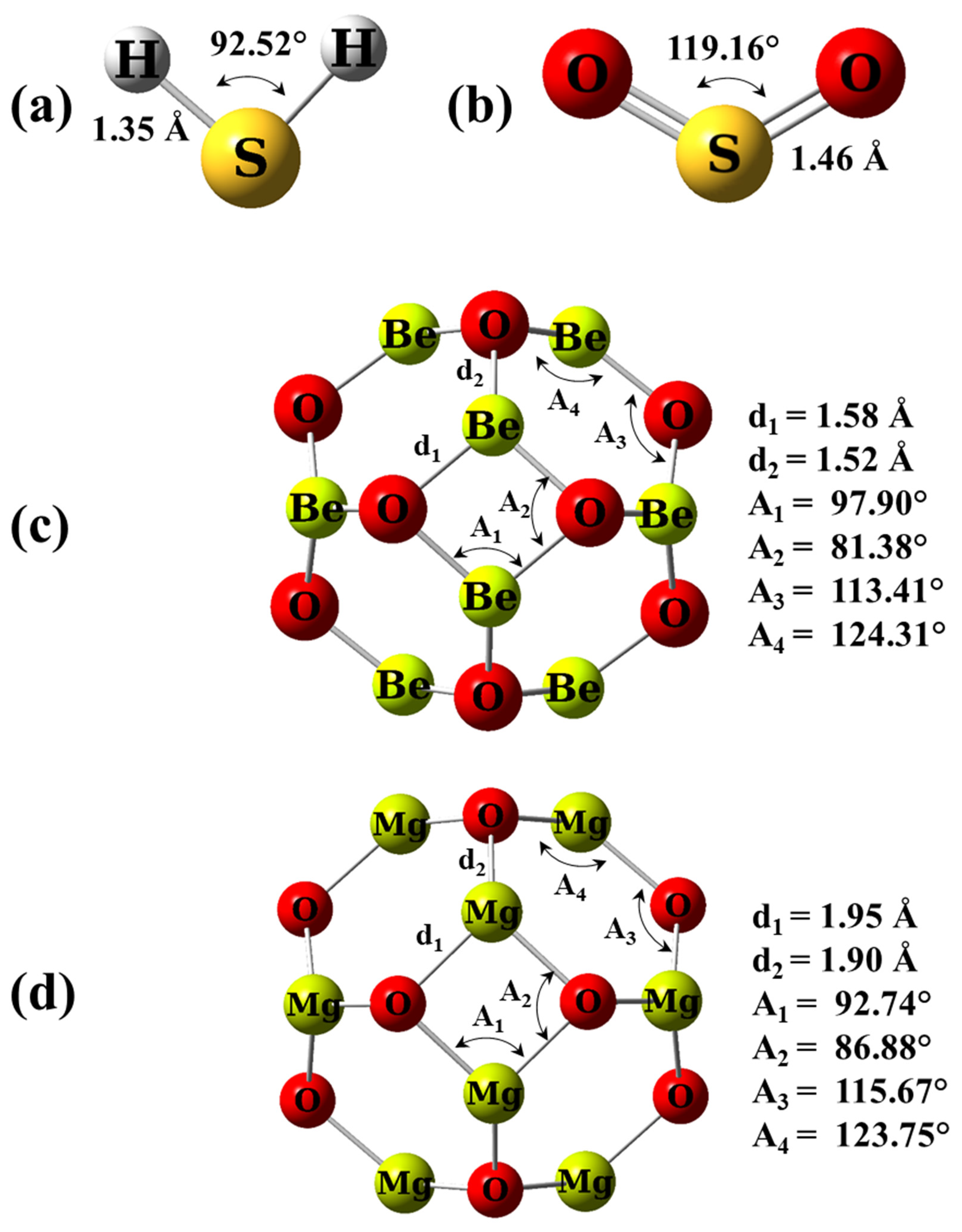
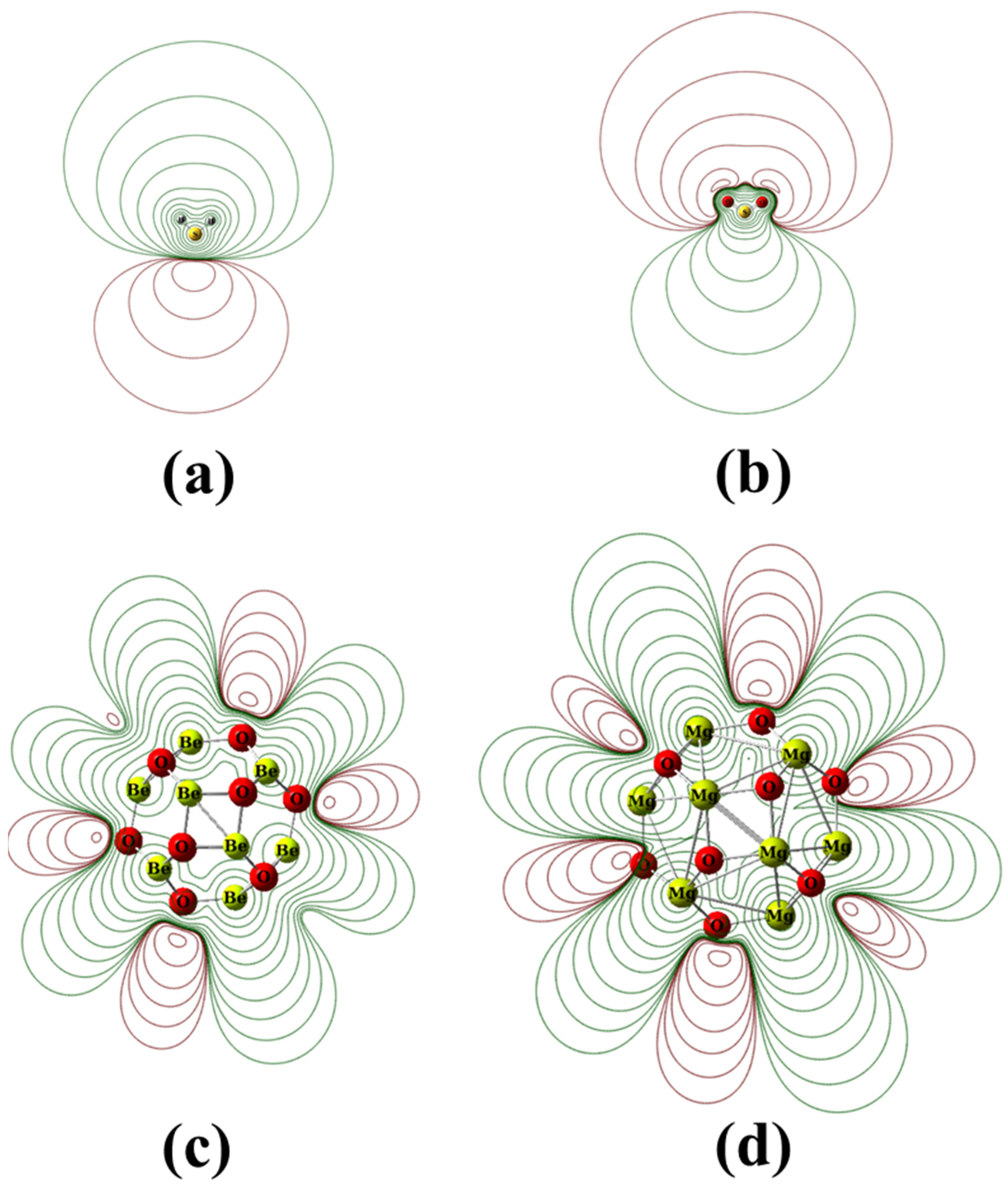

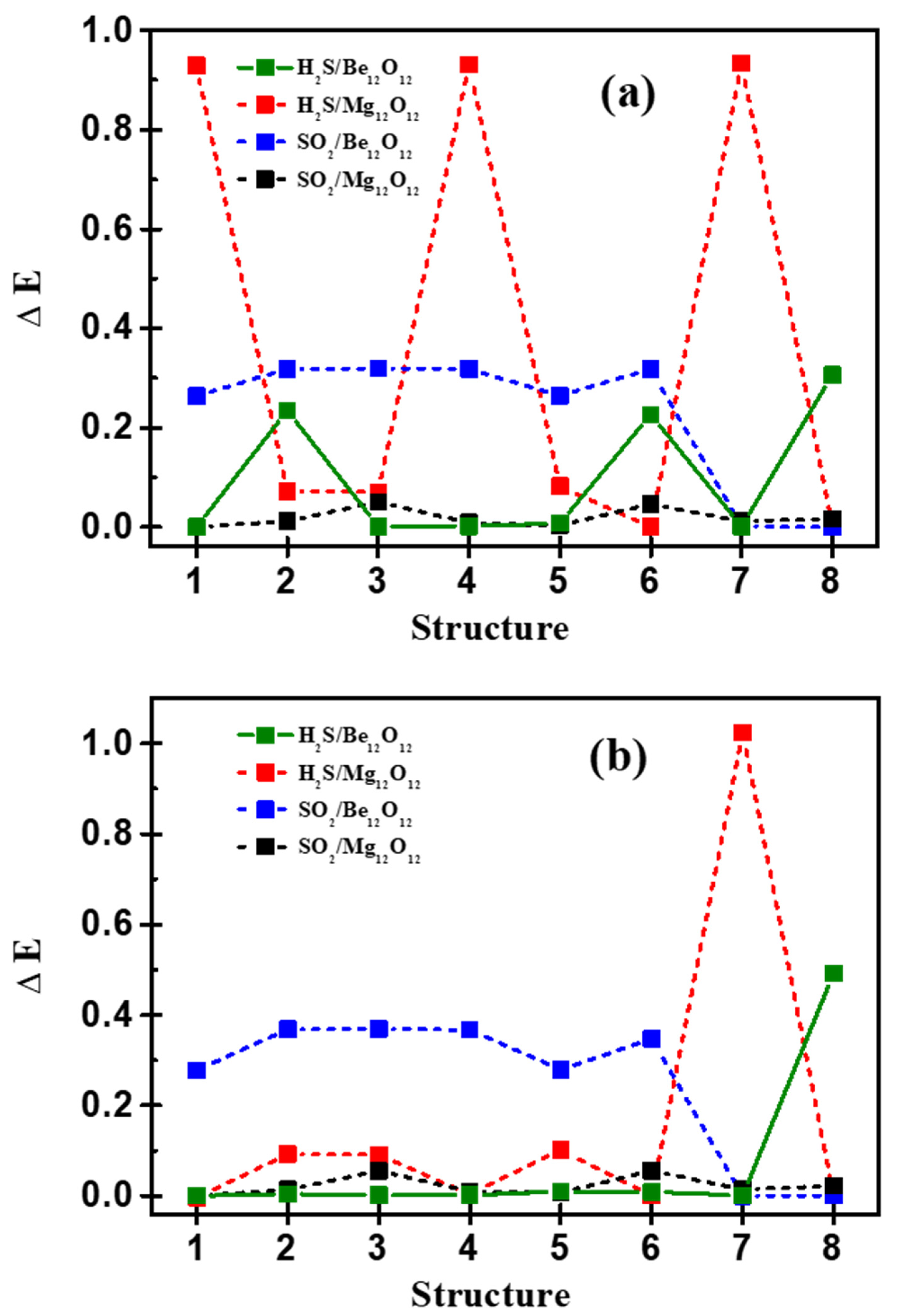
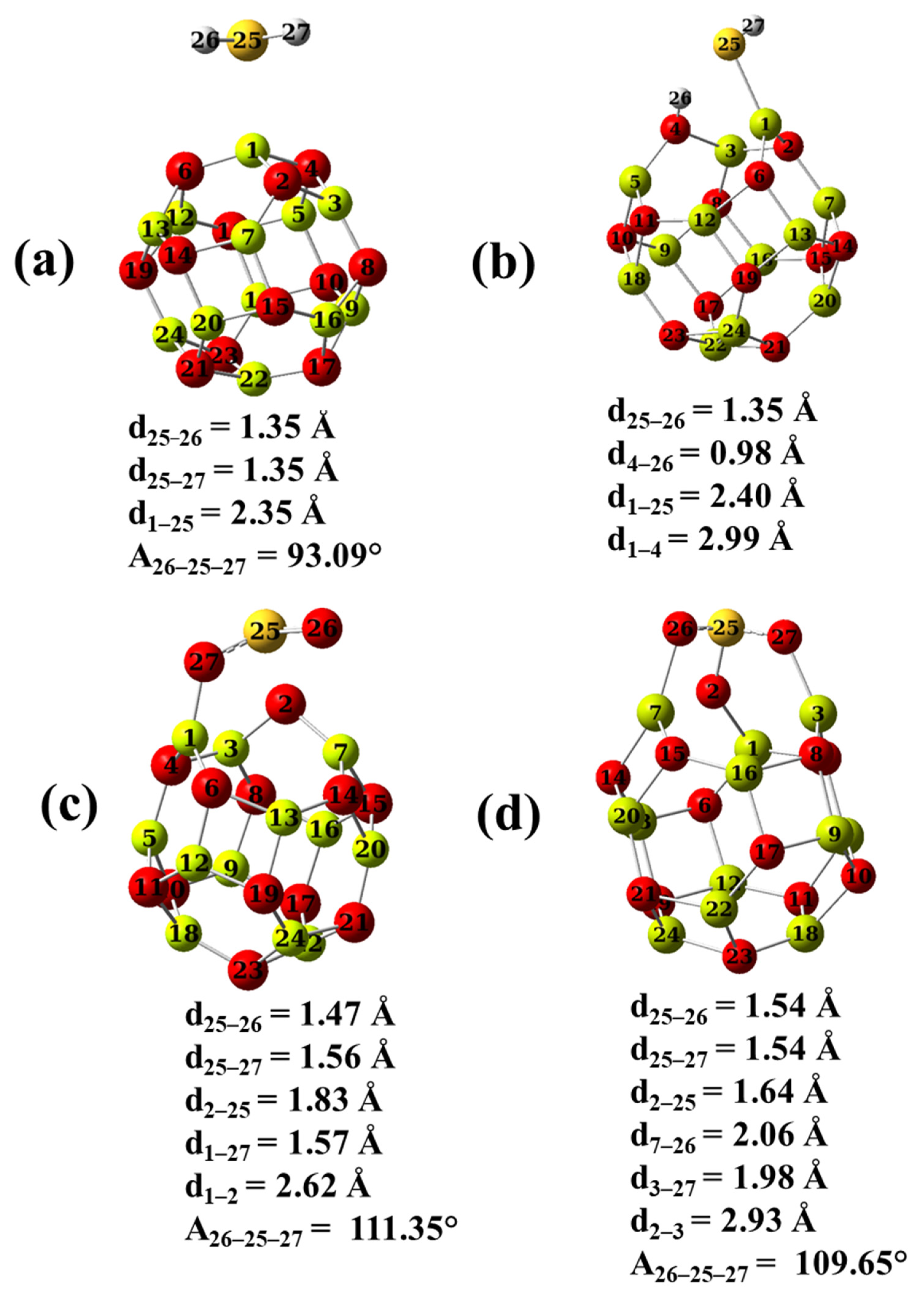
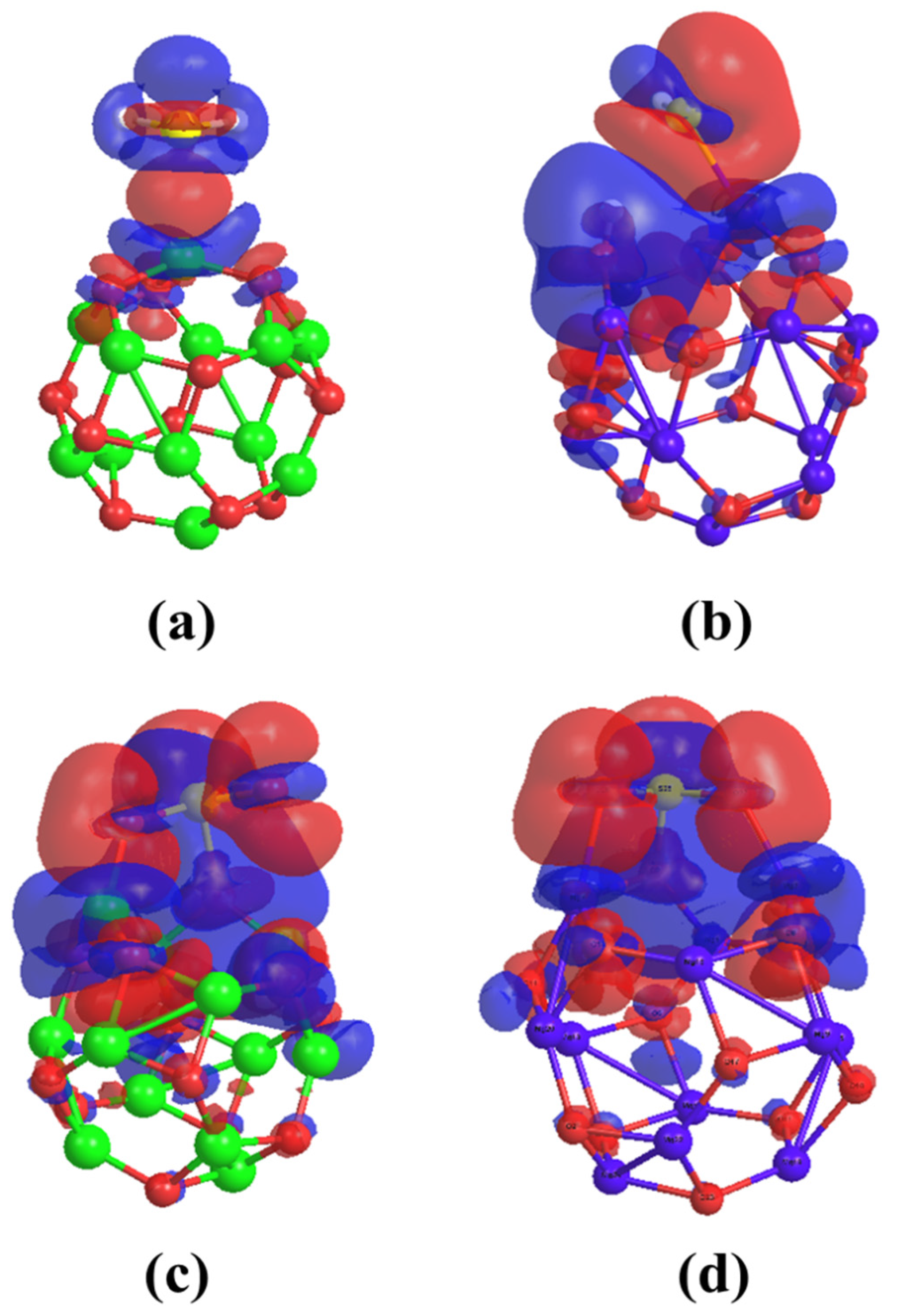

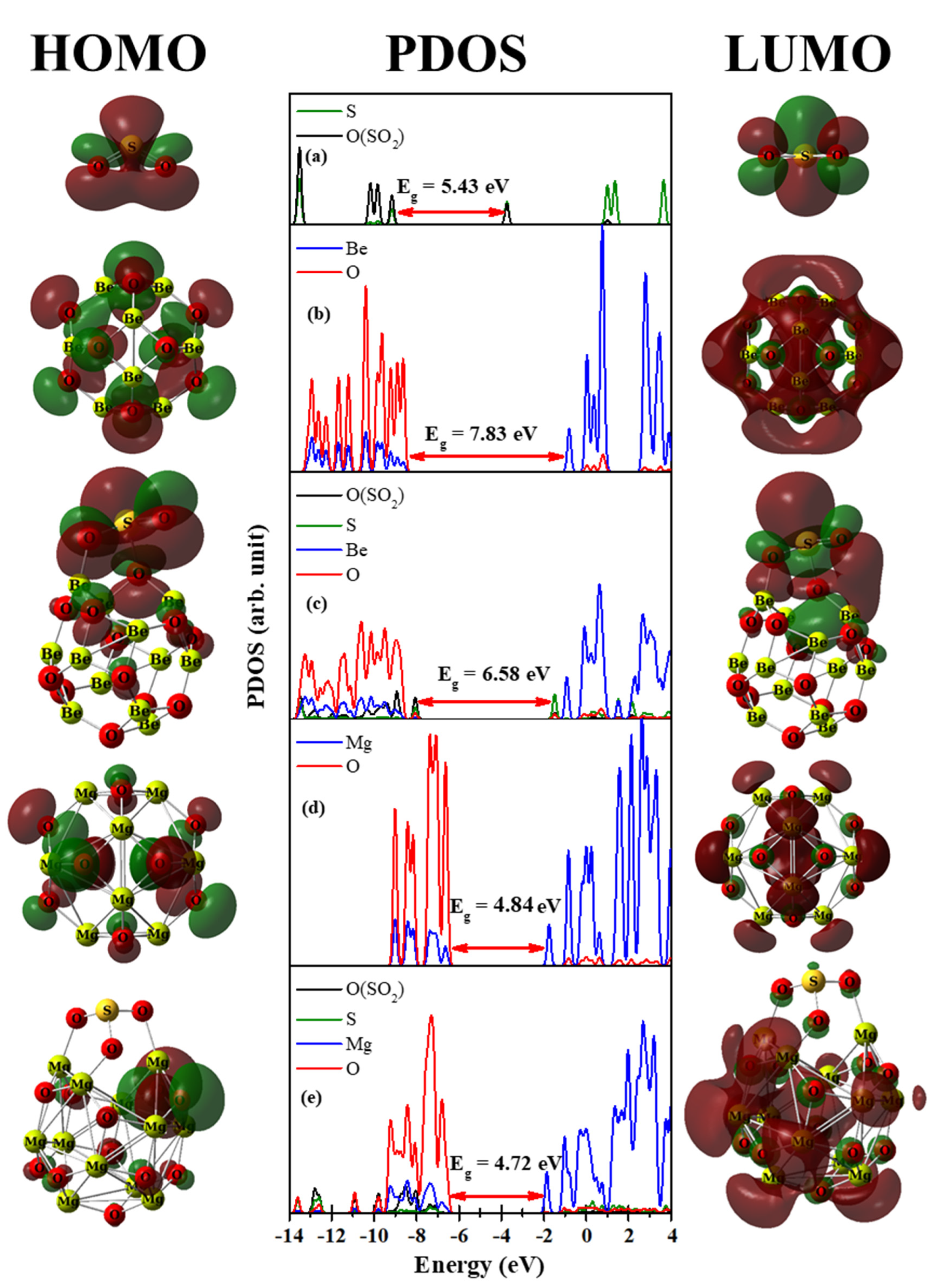

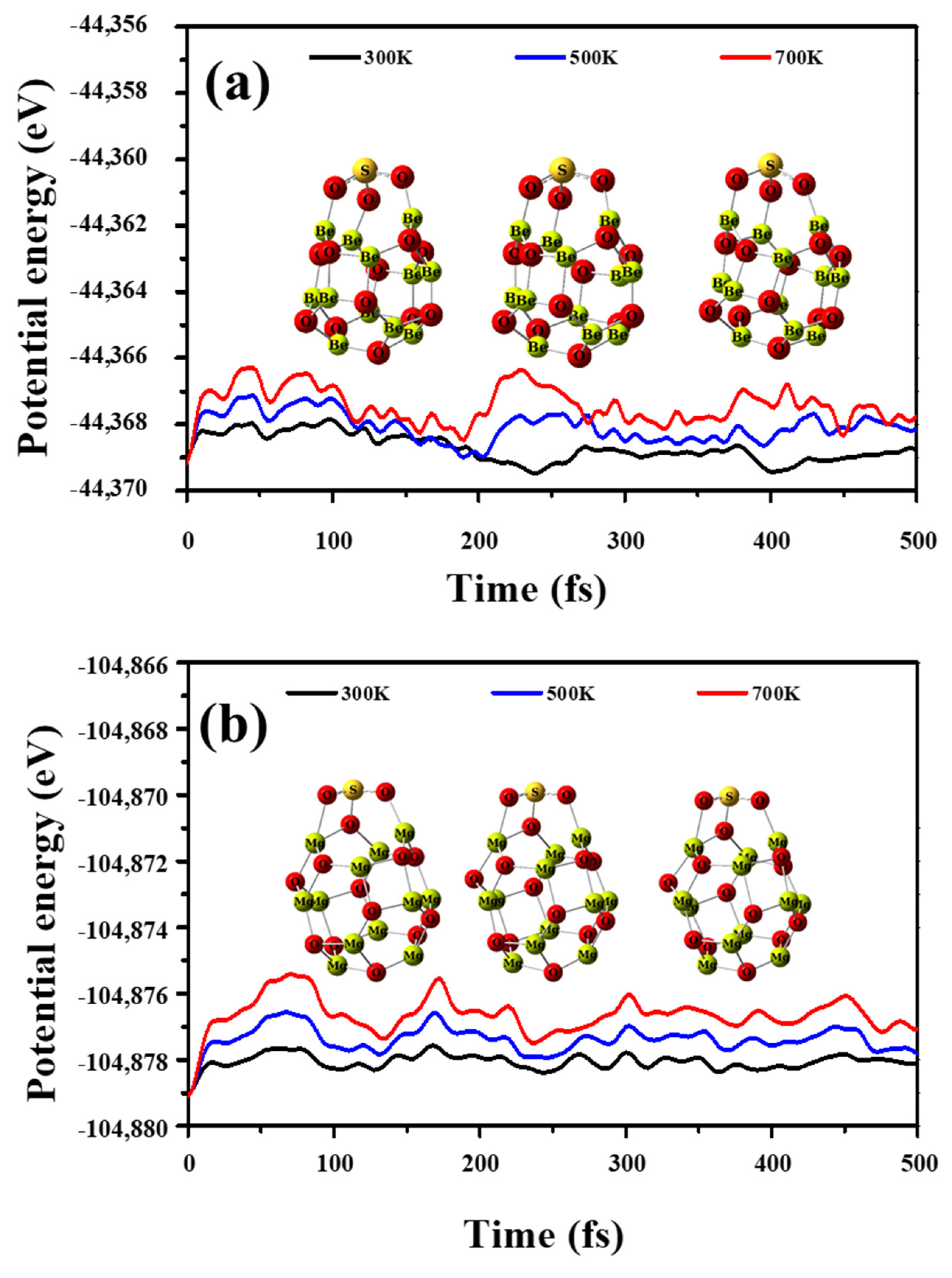

| Be12O12 | Mg12O12 | |||
|---|---|---|---|---|
| Present Study | Previous Studies | Present Study | Previous Studies | |
| HOMO | −8.62 | −8.62 [57] | −6.59 | −6.58 [57], −6.57 [58], −6.60 [38], −6.58 [59], |
| −6.74 [30,31], −6.53 [10] | ||||
| LUMO | −0.79 | −1.07 [57] | −1.75 | −1.78 [57], −1.71 [58], −1.80 [38], −1.72 [59] |
| Eg | 7.83 | 8.29 [43], 7.41 [45], 7.55 [57] | 4.84 | 4.87 [43], 4.83 [45], 4.79 [57], 4.86 [58,59], 4.78 [30,31] |
| IP | 10.27 | 7.98 | ||
| QM | 1.19 | 1.44 | ||
| QO | −1.19 | −1.44 | ||
| µ | −4.71 | −4.17 | −4.14 [58] | |
| η | 3.92 | 2.42 | ||
| ω | 2.83 | 3.60 | ||
| D | 0.00 | 0.01 | 0.01 [58], 0.00 [38], 0.07 [59] | |
| H2S | H2S/Be12O12 | H2S/Mg12O12 | |
| Eads | - | −0.31 (−0.50) | −1.32 (−1.57) |
| BSSE | - | 0.05 (0.05) | 0.09 (0.10) |
| - | −0.26 (−0.45) | −1.23 (−1.47) | |
| HOMO | −7.31 (−7.31) | −8.20 (−8.22) | −5.93 (−5.95) |
| LUMO | 0.26 (0.26) | −0.67 (−0.68) | −1.94 (−1.93) |
| Eg | 7.56 (7.56) | 7.53 (7.54) | 3.99 (4.02) |
| 0.00 (0.00) | 0.23 (0.24) | −0.15 (−0.16) | |
| D | 1.33 (1.33) | 3.27 (3.22) | 5.50 (5.48) |
| SO2 | SO2/Be12O12 | SO2/Mg12O12 | |
| Eads | - | −0.83 (−1.07) | −2.33 (−2.52) |
| BSSE | - | 0.38 (0.39) | 0.41 (0.41) |
| - | −0.45 (−0.68) | −1.93 (−2.11) | |
| HOMO | −9.16 (−9.16) | −8.05 (−8.05) | −6.55 (−6.55) |
| LUMO | −3.73 (−3.73) | −1.47 (−1.49) | −1.84 (−1.83) |
| Eg | 5.43 (5.43) | 6.58 (6.57) | 4.71 (4.72) |
| 0.00 (0.00) | −0.13 (−0.13) | −0.34 (−0.34) | |
| D | 1.94 (1.94) | 2.95 (2.83) | 4.59 (4.58) |
| Structure | Atom | Atomic Charge | Electronic Configuration | ||||
|---|---|---|---|---|---|---|---|
| 1s | 2s | 2p | 3s | 3p | |||
| H2S | H | 0.134 | 0.86 | - | - | - | - |
| S | −0.268 | - | - | - | 1.76 | 4.48 | |
| Be12O12 | Be | 1.186 | - | 0.21 | 0.59 | - | - |
| O | −1.186 | - | 1.69 | 5.49 | - | - | |
| Mg12O12 | Mg | 1.443 | - | - | - | 0.21 | 0.35 |
| O | −1.443 | - | 1.84 | 5.60 | - | - | |
| H2S/Be12O12 | H26 | 0.160 | 0.83 | - | - | - | - |
| H27 | 0.159 | 0.84 | - | - | - | - | |
| S | −0.093 | - | - | - | 1.73 | 4.34 | |
| Be1 | 1.007 | - | 0.25 | 0.73 | - | - | |
| O2 | −1.191 | - | 1.68 | 5.50 | - | - | |
| O4 | −1.189 | - | 1.68 | 5.50 | - | - | |
| O6 | −1.190 | - | 1.68 | 5.50 | - | - | |
| H2S/Mg12O12 | H26 | 0.509 | 0.49 | - | - | - | - |
| H27 | 0.130 | 0.86 | - | - | - | - | |
| S | −0.785 | - | - | - | 1.81 | 4.97 | |
| Mg1 | 1.305 | - | - | - | 0.27 | 0.41 | |
| O2 | −1.452 | - | 1.83 | 5.62 | - | - | |
| O4 | −1.251 | - | 1.77 | 5.47 | - | - | |
| O6 | −1.442 | - | 1.83 | 5.61 | - | - | |
| Structure | Atom | Atomic Charge | Electronic Configuration | |||
|---|---|---|---|---|---|---|
| 2s | 2p | 3s | 3p | |||
| SO2 | O | −0.747 | 1.84 | 4.89 | - | - |
| S | 1.495 | - | - | 1.62 | 2.68 | |
| Be12O12 | Be | 1.186 | 0.21 | 0.59 | - | - |
| O | −1.186 | 1.69 | 5.49 | - | - | |
| Mg12O12 | Mg | 1.443 | - | - | 0.21 | 0.35 |
| O | −1.443 | 1.84 | 5.60 | - | - | |
| SO2/Be12O12 | O26 | −0.852 | 1.84 | 5.00 | - | - |
| O27 | −0.980 | 1.76 | 5.21 | - | - | |
| S | 1.705 | - | - | 1.55 | 2.58 | |
| Be1 | 1.210 | 0.22 | 0.55 | - | - | |
| O2 | −1.109 | 1.75 | 5.36 | - | - | |
| O4 | −1.214 | 1.69 | 5.52 | - | - | |
| O6 | −1.197 | 1.69 | 5.50 | - | - | |
| SO2/Mg12O12 | O26 | −1.003 | 1.82 | 5.17 | - | - |
| O27 | −1.049 | 1.81 | 5.23 | - | - | |
| S | 1.713 | - | - | 1.51 | 2.62 | |
| Mg1 | 1.477 | - | - | 0.20 | 0.32 | |
| Mg3 | 1.468 | - | - | 0.20 | 0.32 | |
| Mg7 | 1.417 | - | - | 0.21 | 0.36 | |
| O2 | −1.148 | 1.82 | 5.32 | - | - | |
| O4 | −1.463 | 1.84 | 5.62 | - | - | |
| O8 | −1.454 | 1.84 | 5.61 | - | - | |
| Structure | H2S | H2S/Be12O12 | H2S/Mg12O12 | |||
|---|---|---|---|---|---|---|
| Overlap Pop. | Bond Order | Overlap Pop. | Bond Order | Overlap Pop. | Bond Order | |
| S–H26 | 0.304 | 0.979 | 0.316 | 0.974 | 0.042 | 0.097 |
| S–H27 | 0.304 | 0.979 | 0.313 | 0.972 | 0.266 | 0.956 |
| S–M1 | - | - | 0.074 | 0.279 | 0.273 | 0.717 |
| O4–H26 | - | - | 0.000 | 0.002 | 0.289 | 0.835 |
| M1–O4 | - | - | 0.206 (0.220) * | 0.538 (0.602) * | 0.035 (0.183) * | 0.106 (0.520) * |
| Structure | SO2 | SO2/Be12O12 | SO2/Mg12O12 | |||
|---|---|---|---|---|---|---|
| Overlap Pop. | Bond Order | Overlap Pop. | Bond Order | Overlap Pop. | Bond Order | |
| S-O26 | 0.242 | 1.773 | 0.302 | 1.706 | 0.203 | 1.290 |
| S-O27 | 0.242 | 1.773 | 0.116 | 1.138 | 0.156 | 1.219 |
| S-O2 | - | - | −0.015 | 0.564 | 0.079 | 0.892 |
| M1-O27 | - | - | 0.262 | 0.614 | 0.000 | −0.010 |
| M3-O27 | - | - | 0.022 | 0.022 | 0.192 | 0.464 |
| M7-O26 | - | - | 0.057 | 0.118 | 0.207 | 0.495 |
| M1-O2 | - | - | −0.006 (0.220) * | 0.028 (0.602) * | 0.113 (0.183) * | 0.267 (0.520) * |
| M3-O2 | - | - | 0.215 (0.220) * | 0.452 (0.602) * | 0.033 (0.183) * | 0.103 (0.520) * |
Publisher’s Note: MDPI stays neutral with regard to jurisdictional claims in published maps and institutional affiliations. |
© 2022 by the authors. Licensee MDPI, Basel, Switzerland. This article is an open access article distributed under the terms and conditions of the Creative Commons Attribution (CC BY) license (https://creativecommons.org/licenses/by/4.0/).
Share and Cite
Badran, H.M.; Eid, K.M.; Baskoutas, S.; Ammar, H.Y. Mg12O12 and Be12O12 Nanocages as Sorbents and Sensors for H2S and SO2 Gases: A Theoretical Approach. Nanomaterials 2022, 12, 1757. https://doi.org/10.3390/nano12101757
Badran HM, Eid KM, Baskoutas S, Ammar HY. Mg12O12 and Be12O12 Nanocages as Sorbents and Sensors for H2S and SO2 Gases: A Theoretical Approach. Nanomaterials. 2022; 12(10):1757. https://doi.org/10.3390/nano12101757
Chicago/Turabian StyleBadran, H. M., Kh. M. Eid, Sotirios Baskoutas, and H. Y. Ammar. 2022. "Mg12O12 and Be12O12 Nanocages as Sorbents and Sensors for H2S and SO2 Gases: A Theoretical Approach" Nanomaterials 12, no. 10: 1757. https://doi.org/10.3390/nano12101757
APA StyleBadran, H. M., Eid, K. M., Baskoutas, S., & Ammar, H. Y. (2022). Mg12O12 and Be12O12 Nanocages as Sorbents and Sensors for H2S and SO2 Gases: A Theoretical Approach. Nanomaterials, 12(10), 1757. https://doi.org/10.3390/nano12101757








